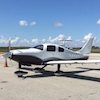24 Oct 2025, 15:33 [ UTC - 5; DST ]
|


|
Page 1 of 1
|
[ 7 posts ] |
|
| Username Protected |
Message |
|
Username Protected
|
Post subject: Piper seneca2 alternators  Posted: Posted: 08 Feb 2024, 21:00 |
|
 |

|
|

Joined: 05/31/15
Posts: 10
Post Likes: +1
Aircraft: Be55
|
|
|
Hello all,
One of the alternators on my seneca2 kicks off during flight and the other one picks up the load, but I cannot reset the failed one in flight. Later on landing, both alternators appear to work as normal. They seem to work properly after engine starts and during run ups everything works properly if I switch one off the other takes the load as it should. Appreciate any thoughts or advice.
Thanks
Steve
|
|
| Top |
|
|
Username Protected
|
Post subject: Re: Piper seneca2 alternators  Posted: Posted: 08 Feb 2024, 22:34 |
|
 |

|
|

Joined: 10/07/18
Posts: 3590
Post Likes: +2572
Company: Retired
Location: Columbus, Ohio
Aircraft: Baron 58, Lear 35
|
|
|
If the problem side will carry all the load you can give it on the ground, the coupling is probably good. Since it works on the ground but will not reset in the air, I’d guess it an intermittent wiring connection issue being cause by the air flow through the cowl moving the wires around. The alternator is down low, in the back, near the cowl flap. In flight, does it make a difference if the cowl flap is open or closed?
|
|
| Top |
|
|
Username Protected
|
Post subject: Re: Piper seneca2 alternators  Posted: Posted: 09 Feb 2024, 17:51 |
|
 |

|
|
 |

Joined: 09/16/10
Posts: 9041
Post Likes: +2084
|
|
|
When this was happening on my Seneca III, it was a (garlock?) seal failing. Engine oil was filling the alternator. Pulled the alternator, it was full of oil.
There were oil drips hanging on the exterior of the alternator.
It would fail after about 20 minutes, the fail. Repeat that for the next flight, sometimes after being off for some time, it would later work on the same flight, but then fail again.
I don't know, is your alternator belt driven, or like what is on the III?
_________________
Education cuts, don't heal.
|
|
| Top |
|
|
Username Protected
|
Post subject: Re: Piper seneca2 alternators  Posted: Posted: 09 Feb 2024, 20:44 |
|
 |

|
|

Joined: 05/31/15
Posts: 10
Post Likes: +1
Aircraft: Be55
|
|
|
Thank you for the suggestions. I may get the mechanic to change the master switch first and see if that does the trick. although he was suggesting getting plane power alternators and regulators that do a better job of load sharing.
|
|
| Top |
|
|
Username Protected
|
Post subject: Re: Piper seneca2 alternators  Posted: Posted: 09 Feb 2024, 20:48 |
|
 |

|
|

Joined: 05/31/15
Posts: 10
Post Likes: +1
Aircraft: Be55
|
|
|
The cowl flaps are closed in cruise and I did not try opening in flight to see if it makes any difference. I will try it.
Thanks
|
|
| Top |
|
|
Username Protected
|
Post subject: Re: Piper seneca2 alternators  Posted: Posted: 10 Feb 2024, 23:06 |
|
 |

|
|
 |

Joined: 01/30/09
Posts: 3843
Post Likes: +2405
Location: $ilicon Vall€y
Aircraft: Columbia 400
|
|
Username Protected wrote: Thank you for the suggestions. I may get the mechanic to change the master switch first and see if that does the trick. although he was suggesting getting plane power alternators and regulators that do a better job of load sharing. They won't. Uggh. The electrical system is really primitive in the Seneca II. The alternators are combined by two big-arse silicon diodes behind the circuit breaker panel. They're big diodes mounted on a big heat sink, because they're old-fashioned diodes with significant voltage drop, so they dissipate a good bit of power. The regulators are solid state, but they're linear and there's a balancing wire between them and the two shall never, ever agree with each other, then they have to sense the voltage through a bunch of wire, and the hidden switch block of the master switch, and the two toggle switches for the alternators. All of which, can build up a few milliohms of resistance as they age, which makes the voltage unstable, so you can enjoy that Piper blinky light syndrome all the time. And Piper, instead of just being sensible and using off-the-shelf current shunts, decided that a length of #6AWG wire coiled up behind the panel would be a suitable shunt, replacing the ammeters with internal shunts that used to catch fire...(not kidding, there was an AD for that). The completely dual electrical system in my Columbia 400 is so, so, so much better. Two alternators, two batteries, two electrical busses with cross-tie capability. Either system can run the whole airplane. It's more complex, but it works so much better.
|
|
| Top |
|

|
Page 1 of 1
|
[ 7 posts ] |
|

|
You cannot post new topics in this forum
You cannot reply to topics in this forum
You cannot edit your posts in this forum
You cannot delete your posts in this forum
You cannot post attachments in this forum
|

Terms of Service | Forum FAQ | Contact Us
BeechTalk, LLC is the quintessential Beechcraft Owners & Pilots Group providing a
forum for the discussion of technical, practical, and entertaining issues relating to all Beech aircraft. These include
the Bonanza (both V-tail and straight-tail models), Baron, Debonair, Duke, Twin Bonanza, King Air, Sierra, Skipper, Sport, Sundowner,
Musketeer, Travel Air, Starship, Queen Air, BeechJet, and Premier lines of airplanes, turboprops, and turbojets.
BeechTalk, LLC is not affiliated or endorsed by the Beechcraft Corporation, its subsidiaries, or affiliates.
Beechcraft™, King Air™, and Travel Air™ are the registered trademarks of the Beechcraft Corporation.
Copyright© BeechTalk, LLC 2007-2025
|
|
|
|



